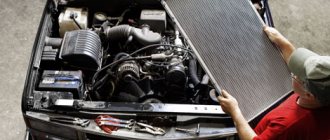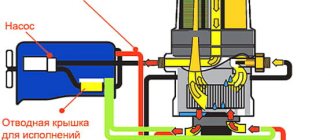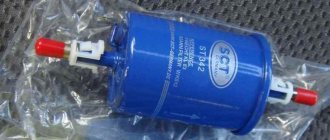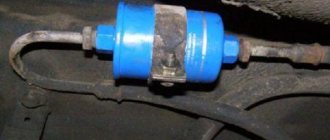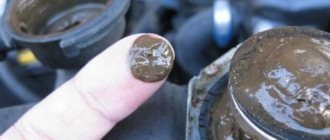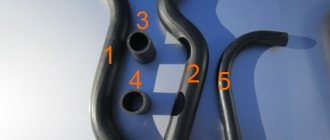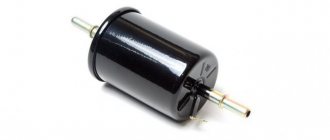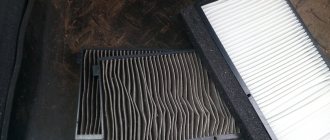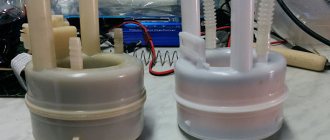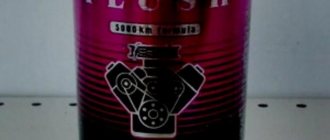Issues of ecology and environmental protection today in many cases become, if not decisive, then extremely important for the operation of vehicles with internal combustion engines.
Thus, according to the requirements of EURO-5, the use of a particulate filter is mandatory for a diesel engine, which ensures the purification of exhaust gases (EG) from particles of unburned fuel. And one of the aspects of its successful operation, which guarantees reliable and durable operation of a diesel engine, is the regeneration of the particulate filter.
A few words about the design
To better understand the problem, and also to consciously take measures to eliminate it, it is necessary to explain what a particulate filter is. This is a mandatory design element of the exhaust system of a diesel engine, usually installed in front of the muffler. You can see how this is done in the figure below:
The figure shows that this device is a complex tubular structure made of ceramic material, having porous walls between the individual channels. Sometimes the walls are coated with a catalyst. When exhaust gas passes from one channel to another, it is possible to get rid of unburnt fuel particles.
However, with operation, the pores in the ceramics become clogged with these particles, which negatively affects the operation of the diesel engine, and the particulate filter must be cleaned to restore its normal performance.
With dismantling
Dismantling can be complicated by the fact that the fastening bolts will have to be carefully cut off and then replaced with new ones. After dismantling, an inspection should be carried out for mechanical damage. After this, a special cleaning liquid is taken, poured into the filter, and the technological holes are clogged. It is also possible to immerse the filter in a container and simply fill it with liquid.
Next you should study the instructions. Typically, cleaning takes 8-10 hours. Only high quality petroleum based fluids should be used. On average, it takes 1 full 5-liter canister. After this, the particulate filter is washed with water and dried thoroughly. When installing, it is better to coat the joints with sealant. After completing the installation, you need to start the engine and warm up the engine. The remaining liquid will come out as steam.
How to clean the particulate filter
In order for its performance to be restored, it is necessary to clean the pores of foreign particles. The car manufacturer provides for a procedure such as regeneration for the particulate filter. She may be:
- passive;
- active.
Passive cleaning
Cleaning the inner surface in this way is quite simple; this is provided for by the design of the filter element itself. The following methods are used:
- Afterburning of unburned fuel particles. To do this, a high temperature is ensured inside the filter (at least six hundred degrees), especially in cases where the engine load is maximum.
- Regeneration using special fuel additives such as urea and EOLYS, which ensure soot combustion at lower temperatures (no more than five hundred degrees).
- Regeneration thanks to a catalytic coating on the inner surface of the ceramic tubes. The use of catalysts and high temperatures leads to oxidation of soot particles (combustion).
Active or forced regeneration
In cases where the tubes become clogged, the power and torque of the engine drop, and the car, roughly speaking, stops moving. The system state is monitored by sensors:
- temperature;
- pressure in the cleaning system;
- air flow.
The particulate filter clogs most quickly in city traffic, as well as when in traffic jams, so this mode is the most harmful for diesel cars. This is due to the fact that with such movement the temperature of the exhaust gases is not high enough to completely burn the soot, so it clogs the pores in the tubes. To restore the car's performance when this happens, it is necessary to burn through the particulate filter.
Purifier options
Next, we will look at the most popular and common liquids for washing particulate filters found on the domestic automotive market.
LM Diesel Partikelfilter Schutz
Liqui Moly product line
Additives from the Liqui Moly company are considered one of the best and most expensive that can be found in Russian and Ukrainian car stores. According to the manufacturer of the substance, these additives are not only highly effective, but also reduce the rate of soot formation. And this, in turn, helps to increase the service life of the element, and also facilitates the operation of the engine as a whole.
The use of this additive, as the manufacturer assures, is especially relevant for diesel vehicles that operate:
- in urban environments;
- in traffic jams;
- at short distances.
Such cars more often than others experience problems with filter element clogging. If the substance is systematically added to the fuel, the condition of the purification component will be maintained clean. This will enable the car owner to avoid expensive repairs and time costs that may arise if a component fails.
One package of Diesel Partikelfilter Schutz is enough to use for 2 thousand kilometers. The manufacturer recommends adding the substance to the car's fuel tank before refueling the car with diesel. One bottle of the substance is enough for 75 liters of diesel. Also, do not forget that overdoing it in this case can only do harm. That is, it is necessary to avoid overdose. In addition, the manufacturer categorically does not recommend using Diesel Partikelfilter Schutz together with substances of other brands.
JLM
JLM flushing agent
This type of additive is also one of the most common among domestic motorists. According to the manufacturer of the consumables, the use of this substance allows for maximum rinsing of the soot cleaning element if you add it once every 10 thousand kilometers. To wash the filter, you need to add JLM to the fuel, after which even the most contaminated element will be cleaned. In addition, JLM allows you to restore the operation of the element in case of regular use of the car in urban conditions.
As for the benefits:
- JLM allows you to extend the life of the exhaust gas treatment system;
- flushing liquid allows you to reduce the cost of unscheduled maintenance or repair work;
- consumables reduce the regeneration rate, which can subsequently lead to mechanical damage to the filter element housing.
It should also be added that JLM has been recommended for use in vehicles:
- Peugeot;
- Citroen;
- Ford.
So the owners of these cars can safely use JLM in their cars.
PROTEC DPF Super Clean additive
Additive for washing PROTEC
A consumable substance for cleaning the particulate filter element of the PROTEC brand has also managed to establish itself among domestic motorists. The manufacturer of the material assures its consumers that if PROTEC DPF Super Clean is regularly used, the car owner will be able to protect his vehicle from breakdown for a long time and reliably.
PROTEC DPF Super Clean, according to the manufacturer, is a highly effective consumable for cleaning the exhaust filter. To flush the element, you need to add a substance to the fuel tank. As for the benefits of using PROTEC:
- The cleaning itself takes place during the operation of the vehicle;
- consumables allow you to eliminate deposits that appear in the particulate filter as much as possible;
- PROTEC flushing liquid does not have a negative effect on the elements of the fuel system, as well as the exhaust gas cleaning system.
- The substance also helps reduce the level of toxicity of exhaust gases.
How to burn through a particulate filter
This can be done in the following ways: Directly by the driver, for which it is recommended to periodically drive a distance of about forty kilometers at a speed of eighty kilometers in low gear. In this driving mode, the exhaust gas temperature rises and forced regeneration occurs, during which the functionality of the particulate filter is restored, which is necessary for the normal operation of the machine in the future.
Burning can be automatically performed by the vehicle's engine control controller by:
- injection of special additives into the fuel that contain cerium and increase the temperature of the exhaust gas;
- late fuel injection;
- additional fuel injection during the exhaust stroke, as a result of which its combustion occurs directly in the exhaust system. The exhaust gas temperature rises, soot particles burn and forced regeneration occurs;
- the use of an additional electric heater installed on the particulate filter (its input).
Causes, signs of pollution and consequences
Regeneration cannot completely remove soot and tar deposits. During operation, they will only increase, thereby limiting the resource. Main signs of contamination:
- increased fuel consumption;
- hissing sounds coming from the exhaust pipe while the engine is running;
- unstable idle speed;
- activation of the SF status indicator on the dashboard;
- difficult engine starting;
- reduction in engine power.
For your information!
Both old and new cars are susceptible to critical contamination of the exhaust system. The service life of the SF depends on the fuel used, as well as the operating characteristics.
Reducing the capacity of the Northern Fleet entails undesirable consequences. In addition to complicating engine starting and increasing exhaust smoke, pollution can cause:
- engine overheating in summer;
- increased fuel consumption;
- power reduction;
- excessive engine wear;
- fuel getting into the lubrication system;
- sensor failure.
Flushing the diesel particulate filter
To restore normal operation of the engine, you can not only burn out the particulate filter, but also the cleaning procedure can be carried out if washing is carried out. During this operation, a special liquid is used, and the procedure itself depends on the product used:
DPF Flushing Liuquid . In this case, the cleaning procedure is performed as follows:
- the particulate filter is removed from the car and its inlet or outlet is closed;
- the liquid used for cleaning is poured inside so that the entire volume is filled;
- the product to be washed is kept in this state for ten hours, and it must be shaken periodically;
- after this time, you need to rinse everything with warm water;
- install the filter on the car and drive a certain distance to evaluate the washing results.
Cleaning liquid "TUNAP MP 131" . With it, the cleaning procedure is performed slightly differently. The standard pressure or temperature sensor is removed, a probe is inserted into the resulting hole, and liquid is sprayed through it onto the particulate filter several times at intervals of five seconds. Then rinsing is carried out using TUNAP MP 132 concentrate.
As a result of such actions, the soot dissolves and is distributed over the entire surface, as a result of which normal regeneration becomes possible. After installation has been carried out, restoring the system to its original state, normal regeneration is manually started, during which the soot and cleaning liquid accumulated on the internal surface are burned.
Washing and regeneration can be performed using means other than those listed, but the examples given should be sufficient to assess the possibility of cleaning using special preparations.
Second way
Washing the filter unit directly on the car
This method allows you to clean the filter without removing it from the car. With this method, manufacturers of cleaning products take into account the possibility of ignition of the composition of the washing liquid. Therefore, solutions with a water-alkaline base are used for washing. They are used in tandem with a flushing mixture that can neutralize alkali after the cleaning process is completed.
For this procedure the following are used:
- set of liquids;
- gun;
- spray;
- probes.
All these elements are sold in a car store or on the market. Allows you to clean the filtration element on any model of diesel car equipped with a particulate filter device. Cleaning is carried out by step-by-step dosing of the incoming cleaner through the hole for the pressure and temperature measurement sensor. Before starting the procedure, the car is warmed up, after which the filter device is allowed to cool to a temperature of 400C. This is the optimal temperature indicator for the effective operation of the alkaline mixture.
To rinse the filtration device, you will need a spray gun; it must be connected to a probe, which will be inserted into the sensor hole. The cleaning agent is sprayed inside the filter, then left for up to 10 seconds. and spray again intermittently. This procedure is repeated several times. To increase the cleaning efficiency of the probe, it is necessary to perform rotational movements around its axis. Then a rinsing agent is used, a second probe is used, and the procedure is repeated in the same way, maintaining a time interval. The result of these manipulations will be a uniform distribution of soot over the surface of the matrix, and it will be possible to burn it out more efficiently.
After the cleaning work is completed, the sensor is installed in its original place, the car engine is started and the car is operated for 20 minutes at medium and high speeds, then regeneration starts or this procedure begins in automatic mode.
About cleaning options
Unfortunately, no matter what cleaning options are used, they are not unlimited. The particulate filter is replaced after its operation with a mileage of no more than 180 thousand kilometers. And since the product is quite expensive, it is worth taking some measures to postpone this procedure.
Premature wear is largely influenced by driving conditions, driving style, and most importantly, fuel quality. If all of these conditions are severe for the vehicle, then replacement may be required much sooner.
Cleaning issues, as well as regeneration, must be under the constant control of the driver. They have a direct impact on the technical condition of the machine and ensure its normal operation.
Main functions
In order to better understand the purpose of these devices, it is necessary to touch upon the topic of exhaust gases. Car exhaust contains a lot of particularly toxic and carcinogenic substances.
Thus, carbon monoxide, unburned hydrocarbons, aldehydes, sulfur oxides, and tetraethyl lead have a very harmful effect on the environment. In addition, the exhaust gases of a diesel vehicle, in particular heavy-duty trucks, contain large amounts of soot.
In order to reduce the concentration of this component, a diesel particulate filter has been introduced into the design of a modern car. What is this detail? This is something similar to a catalyst in a gasoline engine.
What the element looks like
So, this device is designed to neutralize soot - a product formed during the combustion of diesel fuel. There are two types: closed (DPF) and closed with the possibility of regeneration (FAP).
For all their simplicity, in fact, these auto parts for foreign cars have a rather complex structure. Regardless of the design, the filter is a metal cylinder. There are pipes on it - inlet and outlet. The output is connected to the exhaust gas purification system.
The main element of the filter is a special matrix, which is made of silicon carbide.
It is enclosed in a metal cylinder. The structure of this matrix is cellular. As for the cross-section of the cells, this cross-section is often square. But cells with an octagonal shape are more effective.
In addition, the diesel filter has several sensors in its design. This is a sensor that records the pressure difference, and an inlet and outlet temperature sensor.
Reasons for decreased efficiency
There are several reasons why filters become clogged. The main reason is quality. When refueling a car with low-quality fuel, a large amount of soot is formed - the filter quickly becomes clogged, which reduces its service life.
Another reason is insufficient temperature. So, the soot does not burn completely.
The whole point is what a diesel particulate filter is. What is this? It not only traps particles, but also maintains the temperature to burn them. However, it should be said that this happens when the heating of the exhaust gases is high and is no less than 600 degrees Celsius. At lower values, the soot will not burn.
There are also several reasons for the decrease in gas temperature. These are traffic patterns, traffic jams, disruption of the fuel combustion process. Thus, the temperature in the system will not rise if the speed of movement is low, and the movement is accompanied by frequent stops.
